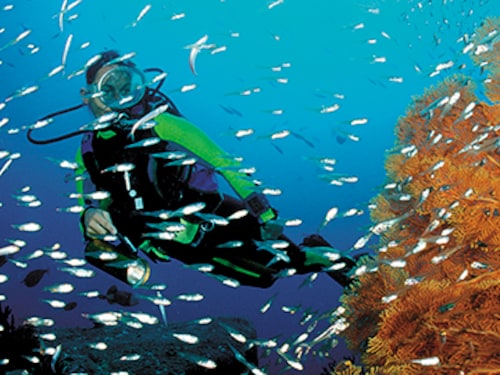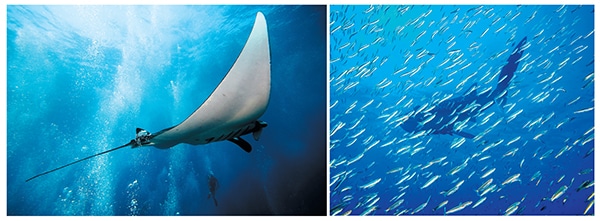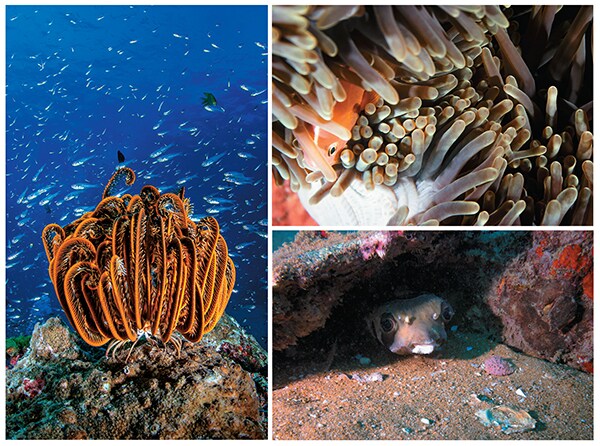Eat, sleep, dive, repeat: The water world off Thailand
The coral reefs off Similan Islands in Thailand offer a tryst with whale sharks, manta rays and the many hues of diversity


It is fairly early on a February morning. I am standing at the edge of the dive platform of a liveaboard yacht as it comes to a halt over a coral reef next to an uninhabited island in the Andaman Sea. The cool breeze cannot obviate the fierceness of the tropical sun. The black neoprene of my wetsuit is quickly absorbing enough heat to start causing some discomfort. The blue water starts to look even more inviting. At the same time, I confess to a tinge of apprehension as I wait for the horn that signals an ‘all clear’ to enter the water. This is not my first trip to the Similan Islands, a marine national park located approximately 100 km north-west of Thailand’s most popular tourist island, Phuket.
My previous visit here was in 2011, a few months after an unprecedented increase in ocean temperature had caused severe ‘bleaching’, destroying a large number of coral reefs across Asia. The Similan Islands were among the worst hit. This was evident on that trip with reef after reef shrouded in deathly grey. Now, as I commence another four-day dive trip here, I am wary of heading home with the same sense of despair that had overcome me four years ago.
The ship’s captain finally sounds the horn, and I follow my dive leader into the water above ‘Anita’s Reef’, a dive site usually selected as the first due to easier conditions. Descending the 30-odd feet to the bottom, my trepidation fades as I swim through a swarm of tiny juvenile fish to a set of boulders lying in the white sand. Patches of colour seem to indicate the revival of the reef. I am less nervous now.Ever since they were declared a protected marine reserve in the 1980s, the Similan Islands have become one of Asia’s most popular scuba diving destinations, accessed by thousands of divers every year between October and April. The islands can be reached by daily speedboat trips from Khao Lak, a small resort town two hours outside Phuket. The ideal way to dive there is via the liveaboard yachts that offer three- or four-day excursions to the best dive spots in the archipelago. A typical day comprises up to four dives at a variety of sites, interspersed with power naps fuelled by generous helpings of Thai cuisine while the vessel navigates its way around the islands.
A couple of dives into the trip and I am already settling into the ‘eat, sleep, dive, repeat’ routine. Routine, though, is hardly how you would describe the hour or so spent underwater.
On the first afternoon, I am at West of Eden, a dive site I have not yet explored. According to the dive guides on board, this area is a good example of the speed at which coral reefs are rejuvenating after the bleaching. (The standard pre-dive briefing highlights what to expect to see in addition to specific safety measures.)
As expected, West of Eden has a moderate current running over it and, descending to the bottom, we leave the line to ‘drift’ over enormous boulders graciously adorned with Gorgonian coral, or sea fans, nourished by nutrient-rich water from the open ocean to the west. A wide variety of fish such as groupers, sweetlips, snappers and angelfish find shelter on the reef while moray eels peek out from the crevices, waiting for night to end before they swim out to hunt. The reef is an explosion of colour ensconced in a bubble of blue and the healthy coral growing all around is heart-warming. Consider the bleak situation I had witnessed just a few diving seasons ago.
Back on the yacht, after the last dive of the day is done, cold wetsuits are discarded for warm towels and I nibble on a plate of fresh fruit as the other divers discuss the many species of marine life they have caught glimpses of. Log books are filled in with varying levels of detail and, as the yacht sails into a sheltered bay for the night, conversations switch to the prospect of what the next few days hold in store.
I rise early for a quick cup of coffee and sandwich before hitting the water by 7.30 am. The first dive is at ‘Elephant Head Rock’, a dive site near the northern tip of the Similan archipelago. It is famed for the underwater rocks that rise barely a couple of metres above the surface giving almost no indication of their sheer enormity below. These rocks create a network of gullies and overhangs underwater—these work as shelters for marine life from strong currents. They are an absolute delight to navigate, especially due to the three-dimensional range of motion that being underwater allows.
As I fin my way along the base of the rocks, squirrelfish stare back at me with their large, black eyes from underneath a coral-encrusted overhang, seemingly confounded by this odd creature blowing a continuous stream of bubbles to the surface. Red-tailed butterflyfish hover nervously near the opening of a ‘swim-through’, a narrow but short tunnel in between two rocks that our dive leader signals us to follow him through. I turn my eyes towards the open water and catch a faint glimpse of a school of barracuda poised majestically in the water column in a gorgeous cylindrical formation extending almost 50 feet down from the surface. Commencing a slow ascent to the top, I turn around to get one more glimpse of this unique underwater landscape which is almost other-worldly in appearance. Image: Getty Images
Image: Getty Images
Sight for sore eyes: If you’re lucky, you’ll spot manta rays, whale sharks and squirrel fish at the Similan and Koh Bon and Koh Tachai islands
Back on the yacht, breakfast awaits and while generous helpings of scrambled eggs are washed down with black coffee, our yacht sails out towards Koh Bon, a dive site I have been secretly waiting for on the trip.
Koh Bon and Koh Tachai, while still a part of the protected marine reserve, lie just outside the Similan Islands and are counted as among the best in the circuit. These sites can be fairly challenging, usually awash with strong currents that bring in plankton-rich water. While this makes for a bit of an underwater workout and lower visibility, the plankton also draws in whale sharks and manta rays.
With my camera primed for some big fish action, I join the other divers and we fin our way along the wall that runs across a part of the dive site. While the soft coral growth and reef life are spectacular, my eyes are continually drawn away in the hope of catching a glimpse of either a manta or a whale shark. However, the ocean yields no such treasures on this dive.
An hour after lunch, I’m back at the edge of the dive platform and my fingers are a little sore from keeping them crossed for the last couple of hours. But I am hopeful. The next dive site, Koh Tachai, was where I had first seen a manta ray. And that fleeting experience from years ago has remained etched in my mind as one that firmly cemented my love for the sea.
Koh Tachai doesn’t disappoint. Just minutes into the water, I see a group of divers pointing past me and I turn around wondering what has caught their attention. Through the school of tiny glass fish that fill the water around me, I see the distinctive shape of a whale shark almost immediately as it moves ever so slowly past the descent line and banks away to swim off into the blue. I am able to fire off a couple of frames before it disappears completely. With more than three quarters of my tank still full, this dive has only just begun.
I turn around to get my bearings, and an enormous manta ray glides into view not more than a couple of feet away. For a moment, I am struck motionless, watching its deltoid wings curl slowly upwards in characteristic elegance, stopping just long enough for me to capture the moment through my camera’s viewfinder before gliding elegantly away.
We begin the next leg of the trip on the third day. This takes us further north outside the Similan Islands to Richelieu Rock. Discovered by the pioneer of underwater exploration, Jacques-Yves Cousteau, Richelieu Rock is an underwater pinnacle that rises from a depth of approximately 40 metres and, at the same time, is just barely visible above the surface during low tide. The site miraculously escaped the destructive effects of the 2010 mass coral bleaching event. This is manifest in the incredibly rich fields of soft coral that cover the dive site almost entirely.  Image: Arijay Prasad
Image: Arijay Prasad
Treasures of the ocean: (Clockwise from top) Among the most exhilarating sights under water are the crinoid or feather star on a reef, clownfish inside a host anemone and pufferfish inside a ship wreck
Popular as it is, some of the inhabitants of Richelieu have acquired near-celebrity status, most notable among which is a tiger tail seahorse that resides in a small crevice at a depth of approximately 27 metres. Over the next few dives at Richelieu Rock, photographic opportunities abound with enormous schools of yellowtail snappers nearly blotting out the sun as they swarm around the top of the dive site and hundreds of anemones littered across its slopes, each with a resident clownfish comically darting in and out of its tentacles. Bigeye trevally hunt along the outer sections of the reef and groups of orbicular batfish let me approach surprisingly close.
As the final dive draws to a close, I allow the magic of the experience to sink in. I have been witness to a rare showcase of the diversity of life supported by our planet, and more than just once. The trepidation with which I started this trip has long faded into hope. I know I am blessed.
First Published: Aug 31, 2015, 06:35
Subscribe Now(This story appears in the Jul 16, 2010 issue of Forbes India. To visit our Archives, Click here.)
